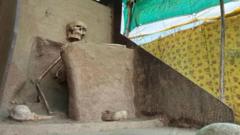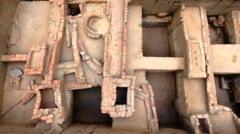A human skeleton dating back a millennium, discovered in a sitting, cross-legged position in India, has finally been moved to a museum six years post-excavation. Initially reported by the BBC, the skeleton had been left in an insecure, tarpaulin shelter at the excavation site in Gujarat since 2019 due to bureaucratic issues.
Now safely transported to a nearby museum in Vadnagar, authorities plan to display the remarkable artifact after completing necessary administrative protocols. Mahendra Surela, the museum's curator, emphasized that the skeleton was moved carefully and under the guidance of numerous experts. The Archaeological Survey of India (ASI) will also conduct an assessment to determine the appropriate way and location for its display.
Archaeologist Abhijit Ambekar, who discovered the skeleton, expressed relief that this significant archaeological find is receiving much-needed attention. He previously noted that such skeletons are rare in India, with similar finds reported only at three other locations.
Despite the excitement surrounding the discovery, the skeleton faced years of neglect while officials debated over its ownership, leading to its unprotected condition near the excavation site. With its historical significance, experts believe the skeleton likely dates back to the Solanki period, a dynasty that ruled Gujarat from 940 to 1300 CE.
Remarkably well-preserved due to undisturbed soil, this skeleton provides invaluable insights into "samadhi burials," a traditional Hindu burial practice honoring revered figures. As it awaits display, experts anticipate the skeleton could offer further understanding of ancient cultural practices in India.





















